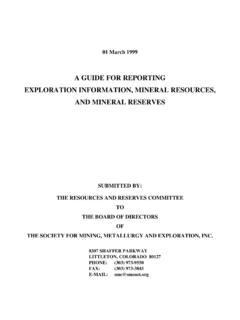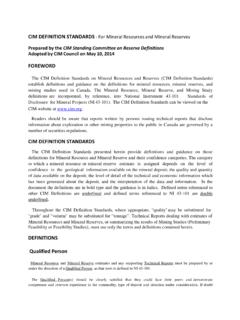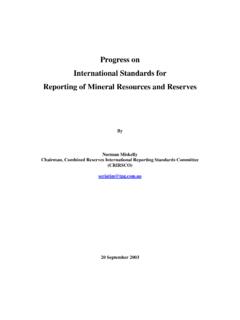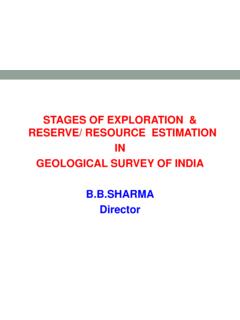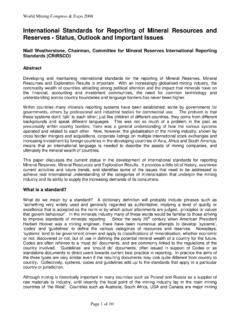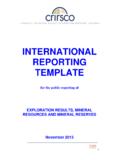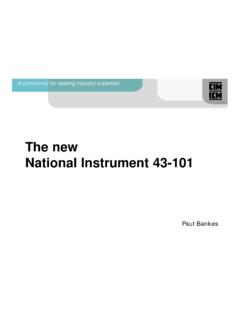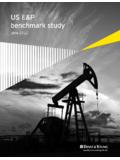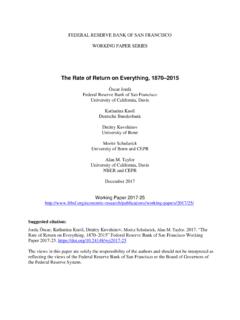Transcription of RESOURCE/RESERVE REPORTING STANDARDS …
1 RESOURCE/RESERVE REPORTING STANDARDS FOR MINERALSP resentation to the International Accounting STANDARDS Board in London by video link from Melbourne. On behalf of the IASB Extractive Activities Project Team 19 April 2005 Pat StephensonMember and past-Chairman April 2005 Outline Background (types of mineral deposits etc)Background (types of mineral deposits etc) What is a mineral resource and an Ore reserve ?What is a mineral resource and an Ore reserve ? JORC Code and other national/international REPORTING JORC Code and other national/international REPORTING standardsstandards Who prepares the estimates (the Who prepares the estimates (the Competent PersonCompetent Person concept)concept) Uses of mineral resource and Ore reserve estimatesUses of mineral resource and Ore reserve estimates Current mineral resource /Ore reserve REPORTING practice Current mineral resource /Ore reserve REPORTING practice in major jurisdictionsin major jurisdictions Current and future developmentsCurrent and future April 2005 Minerals April 2005 Minerals Include Metalliferous minerals gold, silver, copper, lead, zinc, iron, aluminium, tungsten, uranium, mineral sands Non-metalliferous minerals coal, phosphate, diamond, other gemstones Industrial and construction materials sand, gravel, granite, limestone, kaolin April 2005 Types of mineral DepositsMineral deposits can range from.
2 Large scale (billions of tonnes) to small scale (hundreds of tonnes) Continuous to erratic distribution of mineralisation High grade to low grade Very deep (>2-3km) to at surface April 2005 Types of mineral Deposits The larger scale and less erratic the deposit, the wider the drillhole spacing required to confidently estimate resources and reserves, Large coal deposits drillholes may be spaced up to several kilometers apart Small, very erratic gold deposits drillholes may be spaced 10-15m April 2005 Mining Methods Surface mining ( open cut, strip mining, quarry) Underground mining ( block caving, open stoping, cut-and-fill, hand-held) In situ April 2005 Minerals PresentationWHAT IS A mineral resource WHAT IS A mineral resource AND AN ORE reserve ?
3 AND AN ORE reserve ? April 2005 What is a mineral resource ? A mineral Resourceis an estimate of tonnage and grade for a mineralised body, based on sampling of that body The estimate represents a realistic inventory that, under assumed and justifiable technical and economic conditions, might, in whole or in part, become economically extractable Portions of a deposit that do not have reasonable prospects for eventual economic extraction are NOTM ineral April 2005 What is an Ore ( mineral ) reserve ? An Ore reserve is an estimate of the tonnage and grade that is expected to be delivered to the mill or treatment plant It is the economically mineable part of a mineral resource Realistically assumed Modifying Factors (mining, metallurgical, economic, marketing, legal, environmental, social and governmental factors) must be taken into April 2005 Important Points about mineral resource and Ore reserve Estimates resource estimates are ESTIMATES, not calculations.
4 New information or a different geological interpretation can materially change estimates There is no single correct resource or reserve estimate for a given deposit (see later Fish diagram) April 2005 ORE RESERVESORE RESERVESMINERAL RESOURCESMINERAL RESOURCESP robableProvedExploration ResultsInferredIndicatedMeasuredIncreasi ng level of geological knowledge and confidenceConsideration of mining, metallurgical, economic, marketing,legal, environmental, social and governmental factors(the Modifying Factors").Relationship between mineral Resources and Ore April April 2005 mineral resource EstimationRequirements for estimating mineral Resources: Confident geological interpretation High quality, representative samples and assays Application of appropriate estimation techniqueThis comes from: Mapping and sampling the deposit Ensuring the highest STANDARDS of sampling and assaying integrity Employing experienced, qualified professionals ( Competent Persons ) April 2005 The Challenge of mineral resource EstimationImagine several knitting needles penetrating this April 2005 This is the amount of each drill sample that is April 2005 resource Estimation TechniquesThese include: GeostatisticalBlock modelling techniques Statistical Manual.
5 And are applied to the geological and assaying information to yield reliable tonnage/grade estimates are classified and reported in accordance with one of the accepted international REPORTING STANDARDS ( JORC, SAMREC, NI 43/101, REPORTING Code) April 2005 resource Estimation Techniques cont. Block modelling ( Geostatistical) April 2005 resource Estimation Techniques cont. Block modelling ( = drillhole) April 2005 Based on Measured and/or Indicated mineral resource estimate (not Inferred) Realistically derived or assumed Modifying Factors: mining, metallurgical, economic, marketing, legal, environmental, social and governmental Appropriately detailed technical/economic studyOre reserve April 2005 There is no Single Correct Ore reserve Estimate051015202530353456789101112 CutoffNet Present Value ($Mill)
6 0200,000400,000600,000800,0001,000,0001, 200,000 reserve OuncesNPVOz in April 2005 Main Factors affecting mineral resource / reserve Estimates Reliability of geological interpretation Amount, distribution and quality of resource data In nuggety deposits, treatment of very high grades Assumptions regarding mining and treatment methods Assumptions regarding commodity prices and exchange rates Experience and judgment of Competent April 2005 Minerals PresentationJORC CODE AND OTHER JORC CODE AND OTHER NATIONAL / INTERNATIONAL NATIONAL / INTERNATIONAL REPORTING STANDARDSREPORTING April 2005 Australasian Joint Ore Reserves Committee (JORC) Volunteer committee of: The Australasian Institute of Mining and Metallurgy Minerals Council of Australia Australian Institute of Geoscientists Representation by invitation from Australian Stock Exchange Securities Institute of Australia Others if deemed appropriate In continuous existence for over 30 April 2005 Characteristics of JORC-Style REPORTING Standard Principles-based standard: Transparency Materiality Competence Minimum standard for public REPORTING Classification system of tonnage/grade estimates according to: geological confidence technical/economic April 2005 Characteristics of JORC-Style REPORTING Standard (cont.)
7 Requires public reports to be based on work undertaken by an appropriately qualified and experience person ( Competent or Qualified Person ), who can be held to account through a professional association Principle of responsibility with accountability Provides extensive guidelines on RESOURCE/RESERVE April 2005 History of Development of JORC Code and Related REPORTING STANDARDS 1971 - JORC formed 1971 to 1985 - JORC guidelines on classification and REPORTING 1980 - Circular 831, Principles of a RESOURCE/RESERVE Classification ofMinerals , by US Bureau of Mines and US Geological Survey 1989 - First edition of JORC Code 1994 - First meeting of mineral Resources and Reserves International Definitions Working Group (CMMI Group, now CRIRSCO) 1997/98 CRIRSCO agreement, and CRIRSCO/United Nations Economic Commission for Europe (UN-ECE) agreement.
8 Result in virtually uniform international definitions for mineral resource and Reserves 2000 to 2003 Virtually identical REPORTING codes and guidelines adopted by South Africa, Canada, USA (SME), UK/Western European Countries, Chile and Peru, all based on 1999 JORC Code 2004 Release of 2004 JORC April 2005 Current mineral RESOURCE/RESERVE REPORTING StandardsJORC style STANDARDS : JORC Code (Australasia) translations into South American Spanish, Portuguese, Mandarin, Japanese and Russian (in progress) SAMREC Code (South Africa) CIM STANDARDS (Canada, in NI 43-101) The REPORTING Code (UK/Western Europe) SME Guidelines (USA) Chilean and Peruvian Codes CRIRSCO definitions and REPORTING standard template (International in progress) April 2005 Other STANDARDS .
9 UNECE Framework Classification (International) incorporates JORC style definitions for market-related REPORTING , but is broader in scope, covering government inventory REPORTING SEC Industry Guide 7 (USA) not fully consistent with JORC style codesCurrent mineral RESOURCE/RESERVE REPORTING April 2005 Meaning of mineral resource (See Supplementary Slides for full definition) Concentration or occurrence of material of intrinsic economic interest in or on the Earth s crust in such form, quality and quantity that there are reasonable prospects for eventual economic extraction(requires preliminary judgements as to technical and economic criteria) Location, quantity, grade, geological characteristics and continuity are known, estimated or interpreted from specific geological evidence and knowledge Sub-divided, in order of increasing geological confidence, into: Inferred mineral Resources Indicated mineral Resources Measured mineral April 2005 Inferred mineral resource (See Supplementary Slides for full definition) That part of a mineral resource that can only be estimated with a lowlevel of confidence Reasons for low confidence may include.
10 Inadequate geological knowledge Limited sampling data Data of uncertain or poor quality Uncertain geological and/or grade continuity Low in this context means usually not sufficient to allow the application of technical and economic parameters to be used for detailed planning Therefore Inferred Resources may not be converted directly to Ore April 2005 Indicated mineral resource (See Supplementary Slides for full definition) That part of a mineral resource that can be estimated with a reasonablelevel of confidence Reasonable in this context means sufficient to allow the application of technical and economic parameters, and to enable an evaluation of economic viability Therefore Indicated Resources may be converted directly to Ore April 2005 Measured mineral resource (See Supplementary Slides for full definition)

